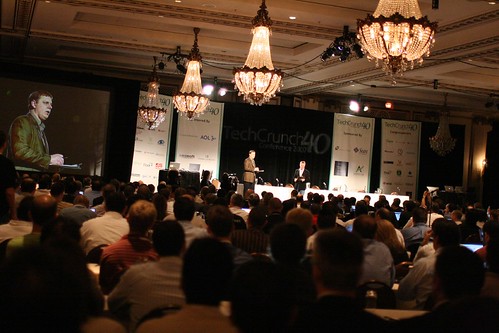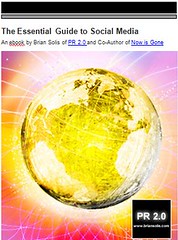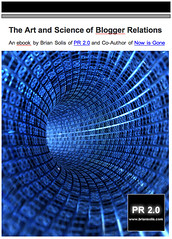The State of Social Media 2008

Source
I’ve been on a recent whirlwind speaking tour recently, sharing and learning all things related to the socialization of marketing and service as well as how to measure these new strategies and tactics. From San Diego to New York to SF back to New York and then Vegas and SF again, I was reminded that no matter how grand an expert one purports to be, the truth is that we’re all still trying to figure this out as it continually changes – together. I’m not talking about what to do or how, but what must be done in order to ensure that this global renaissance paves the way for permanent residence in every media property and business through value, education, and reform.
The world of Socialized Media is maturing and along with it, our knowledge, expertise, reach, and personal and represented brands are only flourishing. It will continue as long as we realize that these new social tools and networks require an entirely new commitment and embodiment of what we personify and how we can be a genuine resource to the people who define the communities that are important to us.
In Technorati’s 2008 State of the Blogosphere report, the company observed that blogging is becoming mainstream, leading the way for an Active Blogosphere - defined as the ecosystem of interconnected communities of bloggers and readers at the convergence of journalism and conversation. I’d also add that as the Active Blogosphere further permeates our daily information consumption and distribution processes, that the Social Web equally becomes pervasive. But, it’s so much more than an Active SocialMediaSphere. As networks become densely populated and new communities arise and thrive, we're experiencing a fundamental shift in content creation, distribution, and consumption, thus creating an Active and Participatory Media society that is inspiring and seeding a more literate and enlightened generation.

Blogs and social networks are now part of our daily lives.
* comScore MediaMetrix (August 2008)
- Blogs: 77.7 million unique visitors in the US
- Facebook: 41.0 million | MySpace 75.1 million
- Total internet audience 188.9 million
* eMarketer (May 2008)
- 94.1 million US blog readers in 2007 (50% of Internet users)
- 22.6 million US bloggers in 2007 (12%)
* Universal McCann (March 2008)
- 184 million WW have started a blog | 26.4 US
- 346 million WW read blogs | 60.3 US
- 77% of active Internet users read blogs

YouTube = 10 percent of all internet traffic (source: Ellacoya Networks)
YouTube & Wikipedia among top brands (source: brandchannel.com)
Five of the top 10 websites are social (source: Alexa)
Over 100 million blogs exist (source: Technorati)
120,000 new blogs launched every day (source: Technorati)
1.5 million posts per day (17 per second) (source: Technorati)
Everyone is a Social Media Expert
You’re a purveyor of new media, but then again, so is everyone else it seems. So what are you going to do to rise above the fray while also delivering true, incontestable value to those you’re helping?
Are you an evangelist or a consultant?
Are you an extension of your company brand or are you an employee?
Are you a leader, follower, or are you meandering through your profession?
Are you confined to the role of a social marketer or do you represent something with longer-term value?
At the end of the day, everything that’s transpiring around us is actually improving the existing foundation for our business, from service to marketing to product development to sales to executive management, and everything in between.
Social marketing revitalizes and empowers every facet of our workflow and its supporting ecosystem. Seeing the bigger picture and tying our knowledge to the valuable feedback from our communities will help us guide businesses towards visibility, profitability, relevance and ultimately customer loyalty.
In every single case, it doesn’t just take an expert; it requires a champion to make an impact.
You are that champion.
Social Media is One Component of Broader Communications Strategy
Yes, everything is changing. Many have drawn the conclusion that Social Media marketers or Social Media consultants are to the new Web, what Webmasters were to Web 1.0. There’s a rush of excitement and enthusiasm tied to entrepreneurialism and significant short-term profitability in leading, creating, and participating in all things Social. This new breed of expert marketers represent the future of marketing communications indeed, but it is a future that is uncharted, undocumented and forever evolving; meaning, social media is not the final frontier, but merely an important chapter in an ongoing saga that will be studied and advanced for years to come.
For every Social Media expert, we must remember, that there are many more human beings out there who are not using social tools to communicate, but are still equally important to our bottom line. Therefore, our job is to connect our story and our value propositions to people wherever they go to discover and share information - even if it's in the real world. Social Media is a critical part of a larger, more complete sales, service, communications, and marketing strategy that reflects and adapts to markets and the people who define them.
Therefore we should be realistic in how we integrate Social strategies into the human-powered machine of listening, learning, engaging and evolving.
Social Media is a lesson.
Social Media delivers new communications tools.
Social Media is a distribution channel.
Social Media is a means, not an end.
Social Media is a revelation that we the people have a voice and through the democratization of content and ideas, we can once again unite people around common passions, inspire movement, and ignite change.
Social Media Takes a Community Effort
Even today, the debate as to who owns Social Media continues. Some argue that advertising or marketing own the conversation, while others claim that it’s the job of public relations or customer service. If we’ve learned anything over the last few years, it’s that socially rooted conversations are not owned by any one person or group. The simple truth is that everyone owns it, including "YOU." Perhaps it’s better said this way, the conversation is omnipresent and not defined, steered or controlled by any one entity.
This isn’t an “either or” discussion. The true value of a more socially aware and focused mindset can positively impact every department within an organization to create a more powerful, harmonious, and effective unity that together builds and nurtures a respected, active, and trusted brand.
The socialization of every department will lend support and direction to the myriad of important conversations taking place, currently without you, across the Web. It’s through this direct engagement that we learn everything. We are privy to unique insight that allows us to walk away more informed and clued-in to the real world perception of our “messages” and story. This valuable info isn’t just relegated to any one group within your organization though. You’ll quickly learn that conversations map directly back to specific departments and thus require knowledgeable responses and voices in order to consistently navigate and sculpt perception and important conversations as they happen.
It’s also the ability and desire to channel and escort valuable feedback among your decision makers within to ensure habitual internal modification to improve the opportunity for relevance and leadership, which is so critical in a time when attention spans are elastic and always thinning.
Building a Bridge Between You and Your Customers
No matter what world you live in, we are all responsible for the public relations of any organization we represent. That’s right. Everything we do, whether we’re in PR or not, reflects on, and contributes to, the brand we represent. Arming employees with knowledge and expertise and empowering them to participate creates an efficient, influential, and community-based organization that stays in sync with stakeholders. Doing so creates an active collective of influential voices, in addition to employees, who will help shape perception and provide help to those seeking advice; the community now becomes an extension of your outbound activities, beliefs, passions, and value propositions.
As marketing, communications, and service professionals with a heightened sense of social awareness, we are not vendors for the ever-growing array of social tools.
We are not cheerleaders for all things social.
We are not talking heads who simply repeat the words of other experts.
We are both architects and builders who are creating the blueprints for and constructing the bridge that connects customers and the people who represent the companies they believe in.
In order to truly help those businesses however, we need to learn through real work. We have to get our hands dirty and there’s no way around it. Actions speak louder than words and the last thing we need are more cooks in the crowded kitchen. We need thinkers AND doers. It is the only way to get smarter and in turn, become more valuable to those you’re consulting or helping.
Immersion = incontestable experience, perspective, and knowledge.
Honestly, there’s too much chatter about the tools and networks that populate the Social Web, when in fact we should concentrate on highlighting not what’s shiny and new, but the sharing of practical methodologies and examples of successes and failures for listening, observing, and learning.
Being Human vs. Humanizing Your Story
It takes so much more than an understanding of the tools and popular networks in order to inspire change and build long-term, meaningful relationships. We must not forget that we need to fuse what works today with the strategies that reach and compel those influencers and tastemakers who live on the edge and thus promote change among those who reside in the center.
It’s our job, duty, and responsibility to reach our community, their way, and teach others to do so along with us, whether it’s from within or externally. In addition, you have to represent much more than social prowess. There’s a bigger, more significant opportunity to make a true impact within an organization. It all starts with a deep commitment to the brand you’re representing, its culture and personality, overall potential, and the people who define the organization, otherwise, you’re pushing training workshops on how to use new social tools, which really doesn’t help you achieve your potential nor the true capabilities of you and your team.
While we all push transparency, we must also swallow the “red pill” to help us find truth and free us from complacency. Whether or not you’re a fan of The Matrix, the red pill symbolizes risk, doubt and questioning, while the “blue pill” represents normalcy, comfort, and routines. Basically, we’re committing to renewal, self-discovery and an openness to changeand learn. It's finding comfort outside of our comfort zones.
It’s one thing to be genuine, but it’s altogether different to translate and effectively communicate what you epitomize to the various markets and what they’re seeking.
Being human is far easier than humanizing your story.
It’s a customer service mentality as opposed to one of customer empathy.
Feel it.
Live it.
Breathe it.
Be it.
If you don’t engage and become an internal champion, someone else will. It's as simple as that. The key difference is that you can definitively demonstrate how your story can impact the day-to-day workflow of various, important leaders and trendsetters, across multiple markets, because you by default, have also become a new influencer in the process of socializing your company . While intent counts, value talks and BS walks.
It's the poetry of relationship building.
Technology is a Runner-up to Social Sciences
While Generation Y (The Millennials) are entering the workforce with unprecedented knowledge of how to communicate with each other using social networks, micromedia communities, blogs, and all things social, their business discipline and work ethic are not comparable to that of Baby Boomers and Generation X. And as such, the technical aptitude of previous generations is locked in a seemingly perpetual cycle of catch-up and education. Each generation, however, is unique and is simply different and representative of the reality that everyone, no matter which generation they represent, still needs to hear, learn, and see things differently. It's psychographics over demographics and the the only way to learn and motivate people is to see and connect with those who band together through tastes, preferences, interests, and passions, regardless of age, location, and gender.
The knowledge of the tools is one thing. But, it's what we hear, say, and learn, that traverses seamlessly across generations and technologies.
Again, Social Media is about people and not the tools. It's about the individuals who collectively form communities and the unique cultures they induce. And in the era of Social Media, people are building and taking residence in global neighborhoods online, creating an extensive hyper connectedness that eliminates the boundaries for relationships. As we've learned over the centuries, communities, cultures, and people are studied through their interactions, behavior, societies, relationships, among many, many other social attributes.
Social Media can best be defined through sociology, rather than technology, to effectively identify, observe, and emulate the cultures of relevant online communities as well as listen to, and respond, directly to the people within them, without disrupting the existing balance.
Sociology - The study of human social behavior, especially the study of the origins, organization, institutions, and development of human society.
Anthropology is the scientific study of people, including the development of societies and cultures.
Ethnography is the study of people in their natural or "native" environments—where they live, work, shop, and play.
Through sociology, anthropology, and ethnography, we’re learning to peel back the layers of our online markets to see the specific groups of people underneath as well as their behavior. As such, we’re starting to figure out that we need to humanize our story and the process of storytelling and engagement. And, through observation, we’re able to find our real customers and those who influence them.
Listeners Make the Best Conversationalists
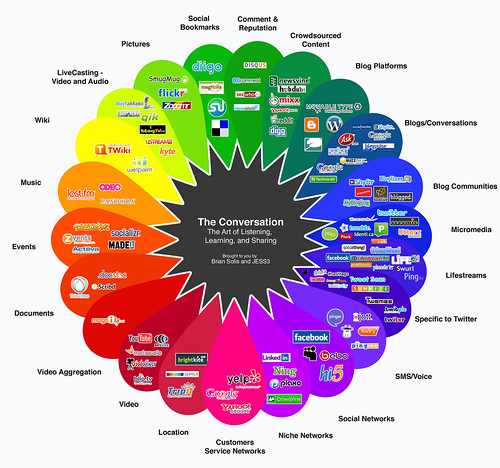
A few months ago, I teamed up with Jesse Thomas to create v1 of the Conversation Prism as a way of capturing and presenting the oft underestimated extent, reach, and depth of the Social Web. While it's been highly regarded as a map of the Web 2.0 landscape, the Conversation Prism is a reference tool for Social Media professionals to start listening to the voices that define and steer your markets. It only features the networks where conversations occur.
Tools and networks will come and go. Popularity will shift across existing, up and coming, and not yet introduced services. If you're not everywhere, then you're only addressing a small portion of a highly vocal contingent that may or may not reflect the perspective of your larger community. And as such, there are important conversations taking place without you right now.
The risk and reality of it all, is that your customers and influential trendsetters could be misinterpreting your value proposition without dispute.
Listening, learning, and participating in a measurable and effective Social initiative requires you to look beyond Twitter and Facebook. Not doing so, handicaps the overall reach and effectiveness of your marketing, communications, and service strategies.
In this current state of Social Media, online conversations, along with real world activity, can not be ignored. Identifying these discussions is only the first step however. It takes much more than running Yahoo or Google searches or setting up Google Alerts to unearth relevant dialogue. Casting a wide net in order to identify where your communities are thriving is the only way to truly identify which networks are important to your brand and business. And, once you understand where these conversations are transpiring, you can observe the cultures, climate and basis for the dialogue to create a participation strategy and also navigate each opportunity to the appropriate person.
In my experience, it's the listening that separates Social Media experts from Social Media theorists. To cross over, take a day, use the Prism as a starting point, and search keywords related to you business, company name, company name+sucks, competitor names, product brands, etc. Document important and relevant discussions and create a Social Map that visually communicates where important dialogue is materializing, where you and your team are needed, as well as maintaining a pulse on your ORM (online reputation management) initiatives.
The Conversation Prism is a living, breathing representation of Social Media and will evolve as services and conversation channels emerge, fuse, and dissipate.
As a communications or service professional, you'll find yourself at the center of the Prism - whether you're observing, listening, trafficking, or participating. Get your ear to the ground and start listening and learning.
Indirect Competitors are the New Direct Competitors
And you thought you were special. OK, you are. But, let's take a look at the horizon so that we can work together to help you keep and actively demonstrate your edge, value, and differentiation.
In an earlier example, we shared how Web 1.0 created a new generation of Web marketing professionals. In the era of the Social Web, many existing disciplines are expanding and evolving their roles to both capitalize on new opportunities and also maintain relevance in the bigger picture of internal transformation. As you survey the landscape, you will quickly discover that you now have a greater array of competition. It's easy to blur where Socialized Marketing ends and each existing discipline, and associated conditioning and training, assume responsibility. And at the same time, we're witnessing the creation of new roles in order to satisfy immediate needs and to also lead experimental initiatives while the rest of the teams figure everything out.
Community managers are quickly becoming the switchboard of all things Social. They keep an ear to the ground and either respond directly or feed each opportunity back into a communications loop to ensure appropriate and timely engagement. Ultimately, what they learn and share impacts each and every division throughout the organization. It's how we improve what we say, what we develop, how we sell, and how we create or amend policies.
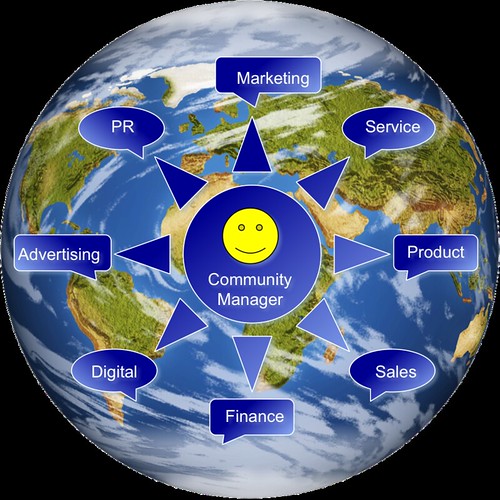
No matter which branch of marketing you represent, you now face direct and indirect competition from new hybrids or mashups of talent, real time capabilities, and strategy. Facing this reality will help you discern how to adapt to the environment you represent as it exists in the current state of a real world as well as a highly competitive and rapidly evolving marketplace.
Everything starts with unlearning what it is you think you know and embracing everything you need to know in today's advancing social climate.
Interactive marketing is clashing with advertising.
Inward-focused Web marketers are grappling with digital content creators.
PR is contending with outsourced relationship managers.
Inbound customer service is wrestling with outbound community outreach.
The point is that we all need to determine what we need to know to compete for the future as professionals while helping the brands we represent compete for mind share in the face of this dispersed attention economy.
We must make emotional connections to the very people we wish to reach and compel to have any hope of building long-term relationships. The study and practice of experiential marketing
teaches us how to shift from a broadcast, us vs. them, process to a 1:1, and eventually many:many, methodology that humanizes and personalizes our story based on the needs of specific individuals and also groups of like minded people.
Looking Ahead to 2009
The democratization of content will further proliferate our global society, transforming traditional media and broadcast industries while also creating new and powerful platforms for citizens with unique perspectives and ideas to cultivate global audiences. And, every business, from mainstream brands to those run by everyday people, will embrace Social strategies to reach existing and potential customers and enthusiasts and demonstrate value, solutions, and expertise.
As someone who's learning how the socialization of marketing affects you, your role, and your company, find comfort in the fact that you are not alone. There are many incredible minds and voices who are sharing priceless information and experiences simply to help you learn and excel. But, it requires dedication, practice, and perhaps most notably, an open mind.
As Social Media-aware professionals, realize that what you know today is quickly leveling across an industry of people who are equally engaged or immersed, thus becoming a,s or more knowledgeable, than you.
As a thought leader, you have something that most don't yet realize. You have people who follow and listen you, which grants you the power to influence, teach and change. You have the experience to create more effective teams that will work together to build an adaptive, customer-focused, and market relevant organization. But, you, we, are still learning. And, the only way to learn is to practice what we preach. We need to make mistakes, experience triumphs, and observe when, why, and how we move the corporate needle and to what extent through our work.
The progression from 2008 to 2009 will place weight and emphasis on new media literacy. Businesses spanning every industry will empower employees to embrace the public through real world and online interactions, requiring a renewed sense of adeptness, passion, and commitment.
Today's experimentation with Socialized marketing will yield and reveal patterns, activity, results, and behavior that will serve as legitimate benchmarks for measuring metrics and ROI. This is already underway and it all starts with studying Web analytics and the decade-long art and science of measuring, monitoring, and improving online experiences and activity. In a genre of social proficiency, we will leverage the insight gleaned from analyzing online events to develop more meaningful and compelling engagement and participation initiatives.
Towards the end of the year, and surely by 2009, marketers leading listening, observation, and participation strategies will witness the end of the chaos associated with manual search, monitoring, trafficking, and tracking. Many aggregation and tracking tools such as BuzzLogic, Radian6, BuzzGain, BrandsEye, Brandwatch, in addition to stealth services not yet launched, will not only track keywords, but also monitor conversations across the networks and communities that you know and don't know to effectively map, engage, and manage participation efforts. Like those in sales and customer service have enjoyed for years, Social marketers and community managers will start to implement and benefit from CRM-style (customer relationship management) dashboards and hubs to streamline internal and outbound communications.
If it's one thing I hope you remember, it's that we have to relinquish any sense of entitlement we've earned or believe we've achieved over the years as the Social Web and the impending Semantic Web, continue to teach and inspire all of us.
Lead by example.
Embrace those who are learning along with you.
We are all in this together, and truthfully, we could be so much more than we are today. Let's embody the change we wish to inspire.
You are part of a new generation that is humanizing the brands you represent and also championing internal transformation to reshape internal business dynamics and policies to establish, maintain, and cultivate loyalty and relationships with the people and influencers who define your markets. And, at the same time, the more you genuinely engage, create compelling and helpful content, and share and aggregate valuable information, you too become a respected, trusted, and influential resource to your communities.
--
Related posts on PR 2.0 (Read these if you haven't already):
- The Essential Guide to Social Media
- New Communication Theory and the New Roles for the New World of Marketing
- Distributed Conversations and Fragmented Attention
- The Value of Online Conversations
- The Social Media Manifesto
- The Socialization of Your Personal Brand
- Will the Real Social Media Expert Please Stand Up?
- The Art of Listening and Engement Through Social Media
- Social Media is About Sociology, Not Technology
- The Social Revolution is Our Industrial Revolution
--
UPDATE: Download a Word or PDF version via Scribd or Docstoc.
UPDATE 2: Caroline McCarthy of CNET writes, "Analyst: Half of Social Media Campaigns Will Flop."
According to Adam Sarner, an analyst with market research firm Gartner, over 75 percent of Fortune 1000 companies with Web sites will have undertaken some kind of online social-networking initiative for marketing or customer relations purposes. But, he added in an interview with CNET News, 50 percent of those campaigns will be classified as failures.
The essence of the post captures much of what resides in the State of Social Media 2008, "(Businesses) will rush to the community and try to connect, but essentially they won't have a mutual purpose, and they'll fail," Sarner said.
When asked whether the faltering economy will mean that businesses are cutting back on this largely unproven field of social media for marketing or customer relations, Sarner said he didn't think so, and that many businesses will turn to the Web to stay in touch with consumers during a difficult financial climate. "This is going to be a lifeline," he said. "You don't ruin your customers, and your spirit of customers is probably the only thing you have."
--
Connect with me on:
Twitter, Jaiku, LinkedIn, Tumblr, Pownce, Plaxo, FriendFeed, Plurk, Identi.ca, BackType, or Facebook
pr pr2.0 pr+2.0 brian+solis socialmedia social+media social media media2.0 media+2.0 public+relations communications marketing publicity brand advertising state union thought leader vision future customer service marcom guru listen leader conversation expert marcom thought+leader



